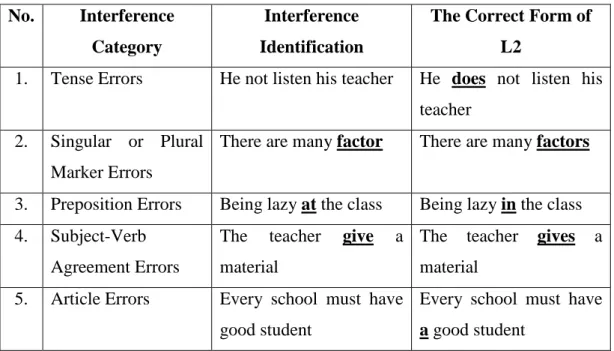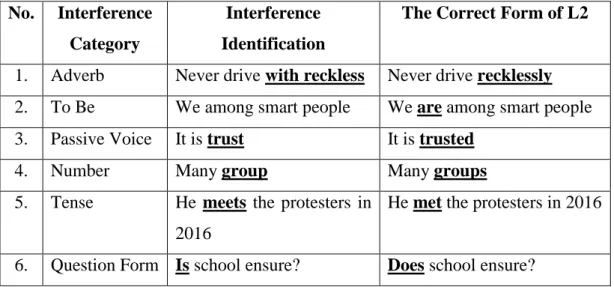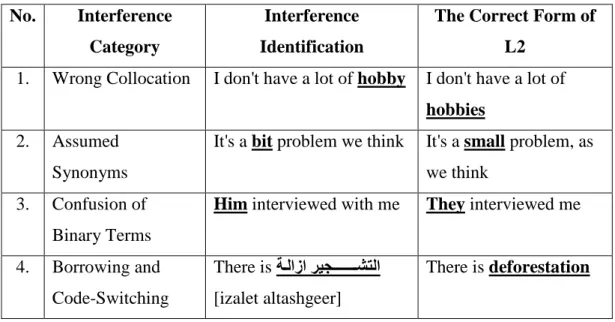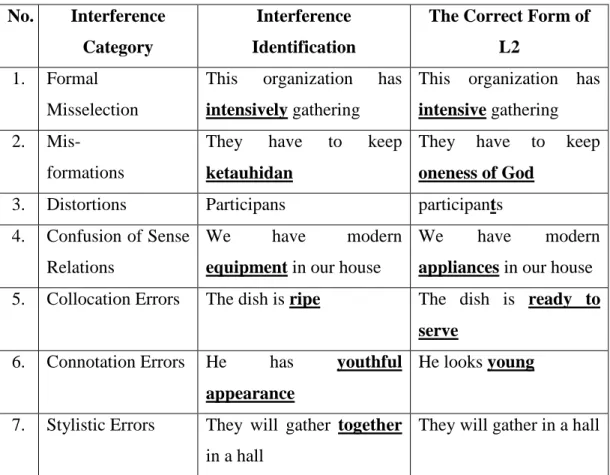Zelvia Liska Afriani, M.Pd atas segala upaya yang telah membimbing peneliti hingga terselesaikannya skripsi ini. Menyelidiki interferensi bahasa pertama terhadap kompetensi komunikatif pembelajar EFL (Analisis komunikasi tertulis mahasiswa dalam kelompok pembelajaran WhatsApp dengan mahasiswa semester empat TBI IAIN Bengkulu tahun ajaran 2020/2021). Ditemukan 133 frekuensi interferensi leksikal, antara lain penyalahgunaan kata depan dengan 24 frekuensi atau 18,04%, pemilihan kata dengan 23 frekuensi atau 17,29%, penghilangan artikel dengan 82 frekuensi atau 61,65% dan penyalahgunaan artikel dengan 4 frekuensi atau 00%.
Sedangkan frekuensi interferensi gramatikal yang ditemukan sebanyak 193 frekuensi, antara lain subject-verb agreement sebanyak 28 frekuensi atau 14,50%, number and quantifier sebanyak 13 frekuensi atau 6,73%, to infinitive sebanyak 8 frekuensi atau 4,14%, penerjemahan kata demi kata sebanyak 12 frekuensi atau 6,21%. . , kalimat pasif dengan 27 frekuensi atau 13,98%, tenses dengan 82 frekuensi atau 42,48%, kata tidak beraturan dengan 11 frekuensi atau 5,69%, dan modals dengan 12 frekuensi atau 6,21.
INTRODUCTION
- Limitation of the Research
- Research Questions
- Research Objectives
- Significances of the Research
- Definition of Key Terms
In addition, Budiharto (2019) investigated the impact of L1 impairments on Indonesian EFL learners' English writing and the learners' common grammatical errors. How often Indonesian grammar and lexical disorders are found in students' communication ability in written communication through learning WhatsApp group. Which factor of Indonesian language interference is dominant in students' communication competence in written communication through WhatsApp learning group.
To describe the frequency of Indonesian grammatical and lexical interference found in the learners' communicative competence in written communication via whatsapp learning group.
LITERATURE REVIEW
The Essence of First Language Interference
Classification of First Language Interference
For example, in the wrong form of agreement, students wrote: "I live with my parents." instead of "I live with my parents." The example showed that the students used the wrong subject-verb in the sentence. For example, students wrote: "The teacher gives the material." instead of "The teacher gives the material." In this case, the students were influenced by the Indonesian language system, where there are no subject-verb agreement rules like in English. For example, students wrote: "We can communicate with teachers." instead of "We can work with teachers." The Indonesian word interaction has the same root as the English word interact, but they have a different meaning.
For example, the learners wrote: "The material from the Internet is better." instead of "The material of the Internet is better." This was because the learners were influenced by the Indonesian adjective comparative degree lebih baik which should be better written in English.
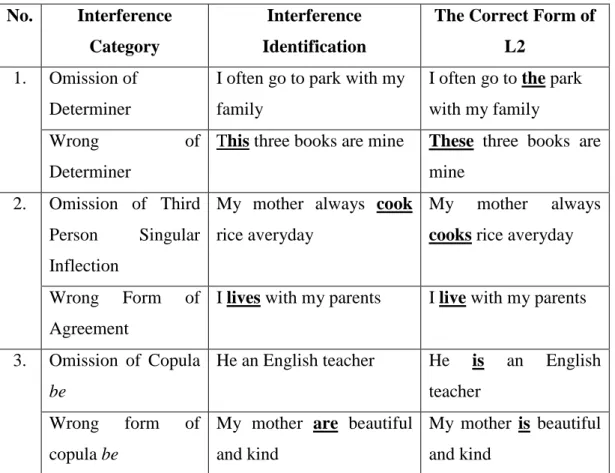
Contributing Factors of First Language Interference
It was because the students were influenced by the word which means dengan in Indonesian language. It is caused by the existence of specific grammatical features of English that are not owned by Indonesian language. It is caused by the existence of specific lexical features of English that are not owned by Indonesian language.
For example, when students write, "I'm listening to music now." instead of "I'm listening to music now." This is because there is no other lexical variant of the verb to listen in the Indonesian language.
Language Error
- The Essence of Language Error
- Categories of Language Error
The errors were in the morphological, syntactic and lexical categories, which were divided into eleven categories. For example, in the morphological category, a student wrote: "The melody of a musical instrument." instead of “The melody of a musical. For example, in the syntactic category, a student wrote, "My favorite songs are similar to the genre of hip hop and rap." instead of "My favorite songs are hip hop and rap genre." In this example, the student added an unnecessary word as in the sentence.
For example, in the morphological category, the student wrote: 'The last and most loved song.' instead of 'The last and most loved song'. In this case, the students selected the wrong comparative adjective form of the word.

Communicative Competence
- The Essence of Communicative Competence
- Models of Communicative Competence
The intra-linguistic source refers to the deviation caused by the characteristics of the L2 itself, while the intra-linguistic source is caused by the interference of the learners' L1. It refers to the ability to know what to say and how to say it depending on the situation, actors, roles and goals. In addition, communicative competence can be defined as the ability to communicate in a situation and context using language forms (sentences, phrases and words) that fit the situation and context and have a plausible meaning.
As a result, mastery of the usage rules and language patterns appropriate to the relevant social situations is essential to a learner's proficiency.
Written Communication
- The Essence of Written Communication
- Significances of Written Communication
- Written Communication in Foreign Language Context
- Disctinction between L1 and L2 Written Communication
The frequency of first language interference found in students' written communication in Whatsapp Learning Group Communication in Whatsapp Learning Group. Each category of lexical interference and grammatical interference will be explained in detail by explaining the data of L1 interference found in students' written communication in the whatsapp learning group. From the 326 data and the analysis that has been done, the three factors proposed by Lott were found in the students' written communication in the whatsapp learning group.
The percentage of factors causing L1 interference at the lexical and grammatical level can be seen from. The first question refers to the frequency of Indonesian grammatical and lexical disorders found in students' communication ability in written communication through WhatsApp learning group. As this analysis examined first language interference in students' written communication in the WhatsApp learning group, lexical interference and grammatical interference were observed.
Meanwhile, grammatical disorders were detected in 193 frequencies of students' written communication in the WhatsApp learning group. In addition, the second question is about the dominant factor that causes language disorders in students' written communication in the WhatsApp learning group. This research analyzed and highlighted the interference of students' first language - Indonesian, which consists of lexical interference and grammatical interference in students' written communication in a WhatsApp learning group.
The result of the research revealed that there were 326 frequencies consisting of lexical interference and grammatical interference in the learners'. Moreover, the three factors causing L1 interference proposed by Lott were found in the learners' written communication in WhatsApp learning group.
Previous Research Review
RESEARCH METHOD
- Research Subjects
- Research Instruments
- Data Collection Technique
- Data Analysis Technique
- Trustworthiness
This method was chosen to identify the frequency and the most dominant factor of Indonesian interference found in students' communication competence in written communication through WhatsApp learning group. However, the data sheet was used to show the frequency and the most dominant factor of Indonesian grammatical and lexical interference found in the students' communication ability in their written communication through. After completing the research and collecting data based on the data analysis in Chapter III, the research result revealed the frequency of L1 language disorders found in students' written communication in the WhatsApp learning group and the most dominant factor causing the disorders.
From the screenshot, it was found that there were many LI-Indonesian disorders in the form of grammatical and lexical disorders in the students' communication ability in their written communication through the WhatsApp learning group. Based on the information above, the vocabulary should be used in the sentence was make because it matches the context of the sentence. Therefore, the subject and verb in date 4 must agree with this grammar rule.
Based on the information above, the word want would be followed by an infinitive, since the sentence was combining the verb to explain. This can be understood because there is no use of the copula in the Indonesian language. For example, a student wrote: "We are from group 1. Sorry if you make a mistake (see Appendix 2)." The vocabulary should be used in the was make sentence because it fits the context of the sentence.
There are two research questions related respectively to the frequency of the first language - Indonesian interference and the factors causing the interference found in learners. In this case, the student was confused about choosing between the definite article and the indefinite article for the nouns in the sentence.
RESULT AND DISCUSSION
Frequency of First Language Interference found in the Learners’
After collecting the data using the screenshot in the Semantics-Pragmatics classes of the fourth-semester students of TBI IAIN Bengkulu, two types of LI interference were found in this research, namely lexical and grammatical interference. Furthermore, the EFL learners also omitted some necessary prepositions that should be used in the sentences. There were 23 L1 interference errors in word choice where the students made a mistake in choosing the appropriate vocabulary to be used in the sentences.
Based on the above datum, the student actually wanted to write the sentence in passive form, but the student was still confused about the appropriate verb. In this case, the sentence still used the base form of the verb's use, where it should be in the form of the past participle. As seen in the table above, the three factors causing interference proposed by Lott were found, namely interlingual factor, overextension of analogy and transfer of structure.
For example, the student wrote: "Okay guys if you don't ask any more (see appendix 8)." The sentence was likely to be translated literally from the Indonesian language. It occurs when learners misuse a vocabulary item because it shares features, whether phonological, orthographic, semantic or syntactic, with a sound in the first language. In this case, the students made mistakes by adding, removing or changing prepositions in the sentences.
The Most Dominant Factor Causing the Learners’ First
Discussion
The highest frequency of the factor causing the lexical interference was the interlingual factor with 112 frequencies or 84.21. The second factor was overextension of the analogy with 14 frequencies or 10.52%, and the lowest frequency of the factor causing the lexical causing interference was the transfer of structure. with 7 frequencies or 5.26. The highest frequency of factors causing lexical interference was the interlingual factor with 112 frequencies or 84.21%, the second frequency was overextension of analogy with 14 frequencies or 10.52%, and the lowest frequency was transfer of structure with 7 frequencies or 5.26.
CONCLUSION AND SUGGESTION
Suggestion
